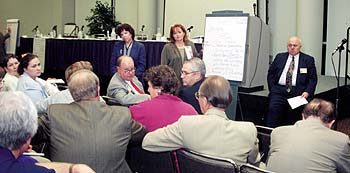Leveling the playing field in veterinary leadership
Women veterinarians are underrepresented in the AVMA House of Delegates, necessitating serious consideration of the formation of a women's caucus to right the inequity in the HOD. This was suggested during a forum at the AVMA Annual Convention in Salt Lake City discussing what the KPMG LLP study concluded about women in today's veterinary profession.
To further effect diversification, there was also talk of the AVMA requiring a proportional number of minorities and women in leadership positions, which are currently dominated by white males.
Sponsored by the Association for Women Veterinarians, the gender issues forum featured a panel comprising members of the board of directors of the National Commission on Veterinary Economic Issues (NCVEI). The commission is using the comprehensive study as a guide to improve the economics of the profession.
Panel members were board chair Dr. James E. Nave, Dr. Lonnie J. King, and board secretary Dr. Michael A. Paul.
The forum served as a primer for the NCVEI National Forum on Veterinary Economic Issues later that day. There, the issue of gender was revisited, but as part of the larger picture of the challenges facing the profession.
In the study summary, released over a year ago, six critical issues were identified. The summary stated that the large numbers of women entering the profession could drive down the already lagging incomes of all veterinarians. This conclusion was based on evidence that women practitioners work fewer hours than their male counterparts, are less likely to be practice owners, and may price their services below those of men.
The reaction among women veterinarians was not surprising. They believe women are being scapegoated for the economic woes of the profession.
The NCVEI and Association for Women Veterinarians have since made amends and agree the profession's troubles are economic, not caused by gender. At the forum, Dr. King noted his wish that the contentious portion of the summary had not been worded so strongly. The profession's dire economic straits have come about while men have been in the majority, he said.
For the women's association and forum attendees, however, the problem remains of women and minorities being underrepresented in leadership positions at all levels.
"Leadership roles in veterinary medicine are not commensurate with the number of women in society," Dr. Shirley Johnston said.
Dr. Johnston observed that fewer than 20 percent in the HOD are women, and more than half the veterinary colleges have no female directors. The NCVEI board itself is predominantly male. Not interested in assigning blame for these inequities, Dr. Johnston wanted rather to find solutions to diversify the leadership of the veterinary profession.

Given the projection that women will dominate the profession in the near future, it is conceivable that women will go their own way if steps are not taken to make organized veterinary medicine more inclusive. Serious consideration should be given, therefore, to requiring that boards, councils, committees have gender composition requirements, and that provisions be made for other leadership positions, according to Dr. Johnston.
Many of these groups already require representatives from certain species groups or geographic areas, but do not equalize gender, she said.
Dr. Paul, past president of the AAHA, cautioned against adopting quotas, however. He worries that quality might be sacrificed in the name of diversification.
One suggestion put forward by attendees was the creation of a women's caucus in the HOD. That way, their concerns could be brought directly to the leaders in the AVMA.
Furthermore, to encourage diversity when seeking leaders from species groups, the AVMA could include on its nomination forms a statement similar to that used by the federal government, that the hiring body is an equal opportunity employer.
"If the AVMA is saying it, I think that's going to help change the culture, that there are highly qualified minorities and individuals" for these key positions, said Dr. Bonnie Buntain, acting assistant deputy administrator of the USDA-FSIS Office of Public Health and Science.
Another concern was whether the AVMA is doing anything through its Governmental Relations Division to increase Social Security benefits for women raising families. AVMA President Dr. Nave explained that the AVMA Legislative Advisory Committee would be looking at that very issue. The recently formed committee is still coming together, having had only two meetings.
Dr. King was asked what the veterinary colleges are doing to alleviate students' high debt load. The dean of the Michigan State University College of Veterinary Medicine said the real problem is low income, not debt. MSU is, however, exploring programs that will bolster graduates' interviewing and negotiating skills, Dr. King said.